
The Iraqi dinar is the currency of Iraq. The Iraqi dinar is issued by the Central Bank of Iraq (CBI). On 7 February 2023, the exchange rate with the US Dollar was US$1 = 1300 dinars.
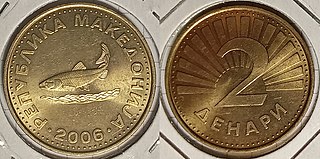
The denar is the currency of North Macedonia. Though subdivided into one hundred deni (дени), coins with a denomination of less than one denar have not been in use since 2013.
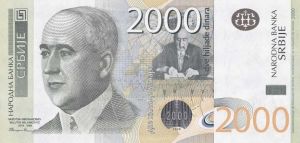
The dinar is the currency of Serbia. The dinar was first used in Serbia in medieval times, its earliest use dating back to 1214. The dinar was reintroduced as the official Serbian currency by Prince Mihailo in the 1868. One dinar was formerly subdivided into 100 para. As of 24 August 2024, 1 US dollar worth 104.57 dinars.

The kuna was the currency of Croatia from 1994 until 2023, when it was replaced by the euro. The kuna was subdivided into 100 lipa. It was issued by the Croatian National Bank and the coins were minted by the Croatian Mint.

The krone was the official currency of Austria-Hungary from 1892 until the dissolution of the empire in 1918. The subunit was one hundredth of the main unit, and was called a Heller in the Austrian and a fillér in the Hungarian part of the Empire.

The rial is the official currency of the Republic of Yemen. It is technically divided into 100 fils, although coins denominated in fils have not been issued since Yemeni unification. Due to the ongoing political instability, the value of the Yemeni rial has fallen significantly.
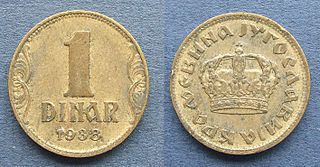
The dinar was the currency of Yugoslavia. It was introduced in 1920 in the Kingdom of Serbs, Croats and Slovenes, which was replaced by the Kingdom of Yugoslavia, and then the Socialist Federal Republic of Yugoslavia. The dinar was subdivided into 100 para.
The dinar was the currency of Croatia between 1991 and 1994. The ISO 4217 code was HRD.

The Krajina dinar was the currency of the Republic of Serbian Krajina between 1992 and 1994.

Verigar was the first postage stamp series of the State of Slovenes, Croats and Serbs, issued in Slovenia after the dissolution of the Austro-Hungarian monarchy at the end of World War I. Although the State of Slovenes, Croats and Serbs was absorbed into the Kingdom of Serbs, Croats and Slovenes in late 1918, the Verigar issue was used on its territory until 1921.

The dinar was the currency of South Arabia, and then South Yemen, and the Republic of Yemen after Yemen's monetary unification on 1 July 1990. It was one of the two official currencies used in Yemen until 11 June 1996. It was subdivided into 1000 fils (فلس).
The Bosnia and Herzegovina dinar was the independent currency of Republic of Bosnia and Herzegovina between 1992 and 1998.
The Republika Srpska dinar was the currency of Republika Srpska between 1992 and 1994 during the Bosnian War. There were two distinct currencies issued by the National Bank of the Republika Srpska. The first was introduced in 1992 in conjunction with the Yugoslav dinar of that year, to which it was equal. The second was introduced on 1 October 1993, replacing the first at a rate of one million to one and matching the revaluation of the Yugoslav currency. Following this, the Republika Srpska used the Yugoslav dinar until 1998, when the Bosnia and Herzegovina convertible mark was introduced.
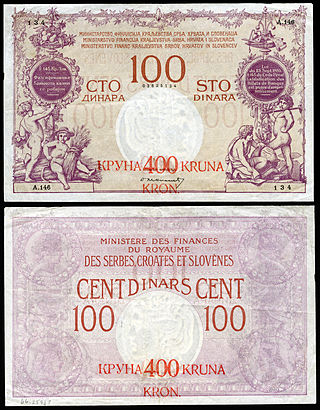
The Yugoslav krone was a short-lived, provisional currency that was originally used in territories of the newly formed Kingdom of Serbs, Croats, and Slovenes, which had previously been part of Austria-Hungary. The currency was first issued in 1919 in the form of rubber-stamped and tagged Austro-Hungarian krone notes. In 1920, to allow the exchange of Austro-Hungarian krone and Serbian dinar notes for the new KSCS dinar, provisional, dual KSCS dinar-krone banknotes were issued with the krone amount overprinted; these notes circulated throughout the country. By 1 January 1923, the provisional notes were withdrawn from circulation and replaced with notes denominated only in dinars. According to the official exchange rate, the Yugoslav krone's value varied from one half of a Serbian dinar at its introduction to one quarter of a Serbian dinar or KSCS dinar at its withdrawal from circulation.
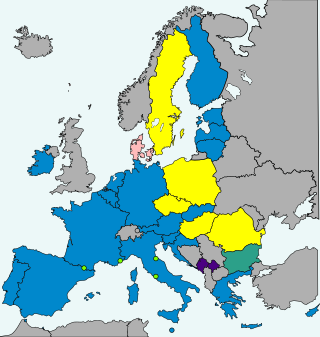
Montenegro is a country in Southeast Europe, which is neither a member of the European Union (EU) nor the Eurozone; it does not have a formal monetary agreement with the EU either. However, it is one of the two territories that has unilaterally adopted the euro in 2002 as its de facto domestic currency and legal tender.

Kosovo adopted the euro as its de facto legal tender in 2002 despite the territory not being a member of the Eurozone or the European Union. This succeeded its use of German marks from 1999.

The kuna was the currency of the Independent State of Croatia from 1941 until 1945. This kuna was subdivided into 100 banica. It was preceded and replaced by the Yugoslav dinar.
The banknotes of the Yugoslav dinar were several series of paper money printed by the central bank of the different consecutive states named Yugoslavia.
From 1775 to 1779, the Continental Congress issued Continental currency banknotes. Then there was a period when the United States just used gold and silver, rather than paper currency. In 1812, the US began issuing Treasury Notes, although the motivation behind their issuance was funding federal expenditures rather than the provision of a circulating medium. In 1861, the US began issuing Demand Notes, which were the first paper money issued by the United States whose main purpose was to circulate. And since 1914, the US has issued Federal Reserve Notes.
This is a description of the current and historical currencies of Croatia, or historically used in the region. The currency of Croatia is the euro, in use since 2023.














